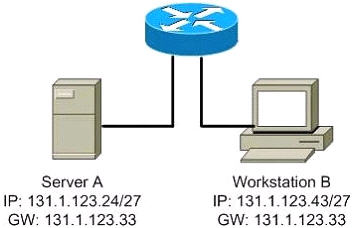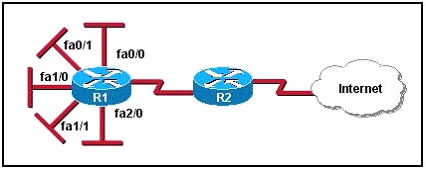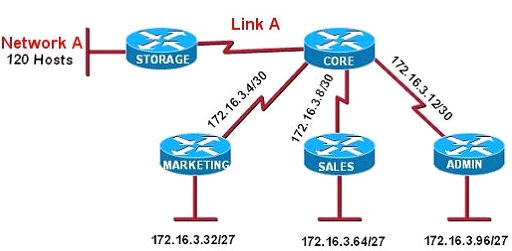CCNA – Subnetting Questions 3
Here you will find answers to Subnetting Questions – Part 3
Note: If you are not sure about Subnetting, please read my Subnetting tutorial.
Question 1
Workstation A has been assigned an IP address of 192.0.2.24/28. Workstation B has been assigned an IP address of 192.0.2.100/28. The two workstations are connected with a straight-through cable. Attempts to ping between the hosts are unsuccessful. What two things can be done to allow communications between the hosts? (Choose two)
A. Replace the straight-through cable with a crossover cable.
B. Change the subnet mask of the hosts to /25.
C. Change the subnet mask of the hosts to /26.
D. Change the address of Workstation A to 192.0.2.15.
E. Change the address of Workstation B to 192.0.2.111.
Answer: A B
Explanation
To specify when we use crossover cable or straight-through cable, we should remember:
Group 1: Router, Host, Server
Group 2: Hub, Switch
One device in group 1 + One device in group 2: use straight-through cable
Two devices in the same group: use crossover cable
-> To connect two hosts we must use crossover cable -> A is correct.
With the subnet mask of /28, 192.0.2.24 & 192.0.2.100 will be in different subnets (192.0.2.24 belongs to subnet 192.0.2.16/28; 192.0.2.100 belongs to subnet 192.0.2.96). To make them in the same subnet we need more space for host. Because 100 < 128 so we the suitable subnet should be /25.
Question 2
Your ISP has given you the address 223.5.14.6/29 to assign to your router’s interface. They have also given you the default gateway address of 223.5.14.7. After you have configured the address, the router is unable to ping any remote devices. What is preventing the router from pinging remote devices?
A. The default gateway is not an address on this subnet.
B. The default gateway is the broadcast address for this subnet.
C. The IP address is the broadcast address for this subnet.
D. The IP address is an invalid class D multicast address.
Answer: B
Explanation
For the network 223.5.14.6/29:
Increment: 8
Network address: 223.5.14.0
Broadcast address: 223.5.14.7
-> The default gateway IP address is the broadcast address of this subnet -> B is correct.
Question 3
Refer to the exhibit. According to the routing table, where will the router send a packet destined for 10.1.5.65?
| Network | Interface | Next-hop |
| 10.1.1.0/24 | e0 | directly connected |
| 10.1.2.0/24 | e1 | directly connected |
| 10.1.3.0/25 | s0 | directly connected |
| 10.1.4.0/24 | s1 | directly connected |
| 10.1.5.0/24 | e0 | 10.1.1.2 |
| 10.1.5.64/28 | e1 | 10.1.2.2 |
| 10.1.5.64/29 | s0 | 10.1.3.3 |
| 10.1.5.64/27 | s1 | 10.1.4.4 |
A. 10.1.1.2
B. 10.1.2.2
C. 10.1.3.3
D. 10.1.4.4
Answer: C
Explanation
The destination IP address 10.1.5.65 belongs to 10.1.5.64/28, 10.1.5.64/29 & 10.1.5.64/27 subnets but the “longest prefix match” algorithm will choose the most specific subnet mask -> the prefix “/29″ will be chosen to route the packet. Therefore the next-hop should be 10.1.3.3 -> C is correct.
Question 4
Refer to the exhibit. The user at Workstation B reports that Server A cannot be reached. What is preventing Workstation B from reaching Server A?

A. The IP address for Server A is a broadcast address.
B. The IP address for Workstation B is a subnet address.
C. The gateway for Workstation B is not on the same subnet.
D. The gateway for Server A is not on the same subnet.
Answer: D
Question 5
Given the address 192.168.20.19/28, which of the following are valid host addresses on this subnet? (Choose two)
A. 192.168.20.29
B. 192.168.20.16
C. 192.168.20.17
D. 192.168.20.31
E. 192.168.20.0
Answer: A C
Question 6
Which of the following IP addresses fall into the CIDR block of 115.64.4.0/22? (Choose three)
A. 115.64.8.32
B. 115.64.7.64
C. 115.64.6.255
D. 115.64.3.255
E. 115.64.5.128
F. 115.64.12.128
Answer: B C E
Question 7
The Ethernet networks connected to router R1 in the graphic have been summarized for router R2 as 192.1.144.0/20. Which of the following packet destination addresses will R2 forward to R1, according to this summary? (Choose two)

A. 192.1.159.2
B. 192.1.160.11
C. 192.1.138.41
D. 192.1.151.254
E. 192.1.143.145
F. 192.1.1.144
Answer: A D
Question 8
Refer to the exhibit. All of the routers in the network are configured with the ip subnet-zero command. Which network addresses should be used for Link A and Network A? (Choose two)

A. Network A – 172.16.3.48/26
B. Network A – 172.16.3.128/25
C. Network A – 172.16.3.192/26
D. Link A – 172.16.3.0/30
E. Link A – 172.16.3.40/30
F. Link A – 172.16.3.112/30
Answer: B D
Explanation
Network A needs 120 hosts < 128 = 27 -> Need a subnet mask of 7 bit 0s -> “/25″.
Because the ip subnet-zero command is used, network 172.16.3.0/30 can be used.
Answer E “Link A – 172.16.3.40/30″ is not correct because this subnet belongs to MARKETING subnet (172.16.3.32/27).
Answer F “Link A – 172.16.3.112/30″ is not correct because this subnet belongs to ADMIN subnet (172.16.3.96/27).
Question 9
Which two subnetworks would be included in the summarized address of 172.31.80.0/20? (Choose two)
A. 172.31.17.4/30
B. 172.31.51.16 /30
C. 172.31.64.0/18
D. 172.31.80.0/22
E. 172.31.92.0/22
F. 172.31.192.0/18
Answer: D E
Explanation
From the summarized address of 172.31.80.0/20, we find the range of this summarized network:
Increment: 16
Network address: 172.31.80.0
Broadcast address: 172.31.95.255
-> Answer D & E belong to this range so they are the correct answers.
Question 10
Which three IP addresses can be assigned to hosts if the subnet mask is /27 and subnet zero is usable? (Choose three)
A. 10.15.32.17
B. 17.15.66.128
C. 66.55.128.1
D. 135.1.64.34
E. 129.33.192.192
F. 192.168.5.63
Answer: A C D
Explanation
First we need to find out the forms of network addresses and broadcast addresses when the subnet mask of /27 is used:
Increment: 32
Network address: In the form of x.x.x.(0,32,64,96,128,160,192,224)
Broadcast address: In the form of x.x.x.(31,63,95,127,159,191,223)
So we only need to check the fourth octets of the IP addresses above. If they are not in the form of network addresses or broadcast addresses then they can be assigned to hosts.
Notice that the IP 66.55.128.1 belongs to the subnet zero and the question says subnet zero is usable so it is valid.
Question 11
Which of the following IP addresses can be assigned to the host devices? (Choose two)
A. 205.7.8.32/27
B. 191.168.10.2/23
C. 127.0.0.1
D. 224.0.0.10
E. 203.123.45.47/28
F. 10.10.0.0/13
Answer: B F
Explanation
This is a time-consuming question (but not hard ^^) because we have to calculate the range of each sub-network separately (excepting answer C is the local loopback address & answer D is a multicast address) so make sure you can do subnet quickly. After solving above questions I believe you can find out the result so I don’t explain this question in detail.
Question 12
How many subnets can be gained by subnetting 172.17.32.0/23 into a /27 mask, and how many usable host addresses will there be per subnet?
A. 8 subnets, 31 hosts
B. 8 subnets, 32 hosts
C. 16 subnets, 30 hosts
D. 16 subnets, 32 hosts
E. A Class B address cant be subnetted into the fourth octet.
Answer: C
Explanation
Subnetting from /23 to /27 gives us 27 – 23 = 4 bits -> 24 = 16 subnets.
/27 has 5 bit 0s so it gives 25 – 2 = 30 hosts-per-subnet.



9tut, Q9 does not make sense. It specifically ask “Which two subnetworks would be included in the summarized address of 172.31.80.0/20?” If you are incrementing by 16 the next network will be 96 not 92. By arriving at 92 you would have to be incrementing by 4 which is a /22 but that is not what the question is asking. Could you please breakdown the question for me? Thanks
@Jamerican: Yes, the next network will be 96 so the current network is from 172.31.80.5 to 172.31.95.255. I didn’t say anything about “92″ in Q9.
Increment: 16
Network address: 172.31.80.0
Broadcast address: 172.31.95.255
Can anyone explain briefly Q1?
I’m a little bit confused about /25 answer
Hi Kagan
How many bits we need to get 100 host 2^7=128 right.. so save 7 bit for host balance 1 bit borrow from host portion to network. so we will get /25…U got it..
Thank you dhina where did the 100 host came from the question?
is it from 192.0.2.100/28?
q9
how did arrive to /22 can someone pls explain thanks
can someone explain Q5 please , isnt the network address is 192.168.20.19 and the broadcast address is 192.168.20.50 , answer c dont seem right to me
Which subnetting section should I see in ICDN1?
Can anyone explain Q7 plz?
sahar
Answer Q7, the network is 192.1.144.0/20 so 192.1.144.0 is network address and broadcast is 192.1.159.0 (144+16-1). 16 because of mask 4 bits on third octet. The host are between 192.1.144.1 to 192.1.159.255.
it is cooolllllllllll
if i learn dumbs so welll i will passsssssssss?
karol
thanks a lot
@mutazzzzzzzzzzzz::
You will pass but not understand. I mean first Study the CCNA Syllabus and i will suggest Todd Lammele’s 7th Edition a very easy to understand book with hands on Exercises and Q&A’s.
after completing the Book then use dumps to practice and you will pass CCNA.
@Chuckles::: Q# 5 Explanation::::
192.168.20.19/28 is an IP address belongs to 192.168.20.16 Network.
as you Know /28 means Increament of 16 so the next Network address is 192.168.20.32
so the valid host are b/w them which are 192.168.20.17 To 192.168.20.30 while the 192.168.20.31 is the broadcast address.
According to Options
A. 192.168.20.29 (belongs to the same range so its correct)
B. 192.168.20.16 ( is the network Address so we will not opt for it)
C. 192.168.20.17 ( is the First Address in the range so Correct)
D. 192.168.20.31 ( is the Broadcast Address and is not valid so incorrect)
E. 192.168.20.0 ( is a net work Address and valid hosts are (1-14)
Regards.
can any ccna professional give me his email so that i can ask him question that i get stuck at in dumps
@Karol
Why u subtract 1 from 16 in the solution of ques:7 {192.1.159.0 (144+16-1)}
can anyone explain Q4 please ?
JJ
In question4 Server A and Server B in /27 network. Valid host range in Network A is 131.1.123.1 to 131.1.123.30 Valid host range in network B is 131.1.123.33 to 131.1.123.62
Here the gateway provided for both network is 131.1.123.33 which comes in Network B subnet not in A. Gateway of Server A is not in the same subnet.
ans. of the ques. no.3 is not clear.
Thanks a lot. So easy explain.
In question no 7:
the subnet we are looking at is : 192.1.144.0-192.1.159.255
where, 192.1.159.255 is the broadcast address
So the valid hosts are 192.1.144.1 – 192.1.159.254
So, why is 192.1.159.2 not selected over the other two options?
kindly correct me if I’m missing any points.
Question 12-is wrong. You didn’t add your bits right. The class B/23 gives you-2^7 or 128 subnets. By taking this class B to a /27, you would add the 4 bits to your 2^7 giving you 2^11 or 2048 subnets.
Excellent site–keep the questions coming!
cn anyone xplain q.no 6???????????
Q7
D and E are the correct answers.
Increment 16 so the Network Address will be: 192.1.140.0; Broadcast: 192.1.155.255. The range is between 192.1.140.1 to 192.1.155.254 so D and E are the correct answers.
Am I wrong? please correct me if so. Ty
I’ve just look better. My mistake about Q7
@mark Terrell /23 means we’ve got 23 bits turned on as 1111 1111.1111 1111.1111 1110.0000 0000 so we’re left with 9 bits for hosts 2 ^ 9 = 512 divided by 32 gives us 16 subnets. /27 it’s 32 hosts minus 2 = 30 hosts so the correct answer should be 16 subnets and 30 hosts. i hope that helps.
Passed CCNA, question 11 from here.
somebody please explain to me q6 ??????
ques no 3 and 11 was in the exam today
@Ali
/22 means Block of 4 i.e. 0,4,8,12 …….
Given Address is 115.64.4.0 therefore It lies between 4 and 8 . Exclude network and broadcast address i.e. 115.64.4.0 & 115.64.7.255 thus all address in between this range are valid.
plz explain
QUESTION 7
I had question 4 on the ICND 2 exam today.
@jimmy
192.1.144.0/20 –> /20 means increment of 16 and belong to 3rd octet. so, 16, 32, 48, 64….., since the choices is higher number, you can easy jump up to 128, 144, 160.. then as you can see network 192.1.144.0/20, what usable ip address belongs to this network address?, looking back to the options, you can correctly select the option A. 192.1.159.2 and D. 192.1.151.254. take note that were looking at the 3rd octet. next network address is 192.1.160.0/20.
It’s very easy~~~~i want hardmode
Please the last version of dump guys
adukmak@gmail.com
plz anyone can help me 1st question ?
Q12 PLEASE CAN ANY ONE EXPALIN IT BREIFLYY ????
Question 12
How many subnets can be gained by subnetting 172.17.32.0/23 into a /27 mask, and how many usable host addresses will there be per subnet?
A. 8 subnets, 31 hosts
B. 8 subnets, 32 hosts
C. 16 subnets, 30 hosts
D. 16 subnets, 32 hosts
E. A Class B address cant be subnetted into the fourth octet.
only 16 subnets gained? i can’t believe it…
i thought
/23–>has 7 bits on–>2^7=128 subnets
/27–>has 11 bits on–>2^11=2048 subnets
#of subnets gained=2048-128=1920
@exam taker
You are attacking the question as if you are completely dumping the /23 mask and then going to an entirely different /27 mask. However, the you are taking the already existing /23 mask: 11111111.11111111.11111110.00000000 and turning it into…
11111111.11111111.11111111.11100000 (/27)
Therefor you are adding 4 bits to the network portion of the address. 2^4=16 subnets
the 5 bits that remain off represent the hosts: 2^5-2 = 30 hosts
So, 16 subnets and 30 hosts.
Good question though, that is tricky.
I think all the questions are right. You must sduty a little more and then you can discuss about them. Thanks 9tut, I’ll make a contribution when I can.
q7
D,E are the correct answers
may someone explain explain to me, the logic behind Q3
Karol thanks a lot for your explanation about Q7. Bless you.
Pliz i will sit for the CCNA exam next month, can someone send me the latest dumps on email: olesimbe@yahoo.com
can someone explain question 7 please?
you can explain q5??? thanks…
because D incorrect?
Yes, this is just I’m talking about!..Hotmail doesn’t remvoe my email domain from black list.Michel, my apologies; I emailed you invoice from my Yahoo account just minute ago, please check your mailbox.Regards,Andrey.